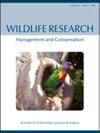Do high recapture rates indicate representative sampling? The relationship between recapture probability, risk-taking, and personality
IF 1.6
3区 生物学
Q3 ECOLOGY
引用次数: 0
Abstract
ABSTRACT Context. Monitoring programs provide valuable information on wildlife populations, thereby underpinning strategies for conservation and control. For threatened species, where every animal represents a substantial portion of the population, representative sampling is vital. One fundamental challenge during sampling is understanding drivers of survey bias; for instance, behavioural heterogeneity in trap response. Methods such as capture–mark–recapture have long been used to estimate capture and recapture heterogeneity; yet, this method, like many others, is able to gather data only from the trappable and re-trappable portion of the population; a problem that presents a particular challenge for small or vulnerable populations. A greater understanding of why biases arise can result in improved survey methods, more reliable survey data and increased modelling accuracy. Aims. We focus on an endangered species with unusually high recapture probabilities (0.78–0.92), namely, the mountain pygmy-possum (Burramys parvus). Specifically, we examine whether, within a single trapping session, a recapture bias exists either as a function of past trapping experience or personality. Methods. We tested whether recapture probability differs among cohorts with different capture histories (‘known’ animals captured during trapping sessions in previous years vs ‘new’ animals trapped for the first time in this study). We also tested for individual personality, general risk-taking behaviour during foraging, and subsequent links to recapture probability. Key results. Recapture probability was significantly affected by cohort. New animals had lower probabilities of recapture and took fewer risks during foraging than did known animals. Although personality did not significantly influence recapture probability, it did influence risk-taking during foraging. Conclusions. Despite high recapture probability within the populations, captures were significantly skewed towards a subset of the population, likely being due to different perceptions of risk among individuals. Implications. Understanding potential sources of bias during live-capture surveys is the initial step towards modifying and improving surveys to reduce sampling biases and to ensure representative population sampling.高回收率是否表明有代表性的抽样?再获概率、冒险和个性之间的关系
本文章由计算机程序翻译,如有差异,请以英文原文为准。
求助全文
约1分钟内获得全文
求助全文
来源期刊

Wildlife Research
生物-动物学
CiteScore
4.30
自引率
15.80%
发文量
56
审稿时长
3 months
期刊介绍:
Wildlife Research represents an international forum for the publication of research and debate on the ecology, management and conservation of wild animals in natural and modified habitats. The journal combines basic research in wildlife ecology with advances in science-based management practice. Subject areas include: applied ecology; conservation biology; ecosystem management; management of over-abundant, pest and invasive species; global change and wildlife management; diseases and their impacts on wildlife populations; human dimensions of management and conservation; assessing management outcomes; and the implications of wildlife research for policy development. Readers can expect a range of papers covering well-structured field studies, manipulative experiments, and analytical and modelling studies. All articles aim to improve the practice of wildlife management and contribute conceptual advances to our knowledge and understanding of wildlife ecology.
Wildlife Research is a vital resource for wildlife scientists, students and managers, applied ecologists, conservation biologists, environmental consultants and NGOs and government policy advisors.
Wildlife Research is published with the endorsement of the Commonwealth Scientific and Industrial Research Organisation (CSIRO) and the Australian Academy of Science.
 求助内容:
求助内容: 应助结果提醒方式:
应助结果提醒方式:


